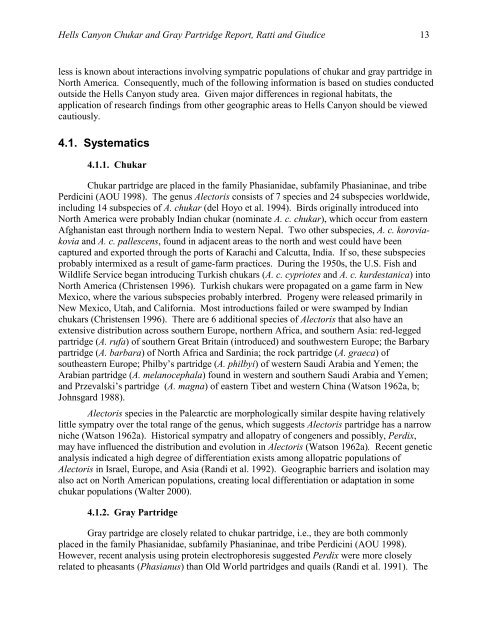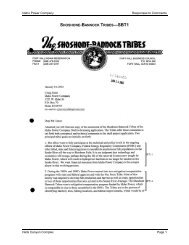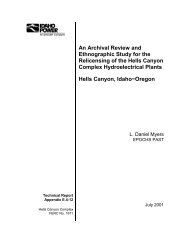Assessment of Chukar and Gray Partridge Populations - Idaho Power
Assessment of Chukar and Gray Partridge Populations - Idaho Power
Assessment of Chukar and Gray Partridge Populations - Idaho Power
- No tags were found...
You also want an ePaper? Increase the reach of your titles
YUMPU automatically turns print PDFs into web optimized ePapers that Google loves.
Hells Canyon <strong>Chukar</strong> <strong>and</strong> <strong>Gray</strong> <strong>Partridge</strong> Report, Ratti <strong>and</strong> Giudice 13less is known about interactions involving sympatric populations <strong>of</strong> chukar <strong>and</strong> gray partridge inNorth America. Consequently, much <strong>of</strong> the following information is based on studies conductedoutside the Hells Canyon study area. Given major differences in regional habitats, theapplication <strong>of</strong> research findings from other geographic areas to Hells Canyon should be viewedcautiously.4.1. Systematics4.1.1. <strong>Chukar</strong><strong>Chukar</strong> partridge are placed in the family Phasianidae, subfamily Phasianinae, <strong>and</strong> tribePerdicini (AOU 1998). The genus Alectoris consists <strong>of</strong> 7 species <strong>and</strong> 24 subspecies worldwide,including 14 subspecies <strong>of</strong> A. chukar (del Hoyo et al. 1994). Birds originally introduced intoNorth America were probably Indian chukar (nominate A. c. chukar), which occur from easternAfghanistan east through northern India to western Nepal. Two other subspecies, A. c. koroviakovia<strong>and</strong> A. c. pallescens, found in adjacent areas to the north <strong>and</strong> west could have beencaptured <strong>and</strong> exported through the ports <strong>of</strong> Karachi <strong>and</strong> Calcutta, India. If so, these subspeciesprobably intermixed as a result <strong>of</strong> game-farm practices. During the 1950s, the U.S. Fish <strong>and</strong>Wildlife Service began introducing Turkish chukars (A. c. cypriotes <strong>and</strong> A. c. kurdestanica) intoNorth America (Christensen 1996). Turkish chukars were propagated on a game farm in NewMexico, where the various subspecies probably interbred. Progeny were released primarily inNew Mexico, Utah, <strong>and</strong> California. Most introductions failed or were swamped by Indianchukars (Christensen 1996). There are 6 additional species <strong>of</strong> Alectoris that also have anextensive distribution across southern Europe, northern Africa, <strong>and</strong> southern Asia: red-leggedpartridge (A. rufa) <strong>of</strong> southern Great Britain (introduced) <strong>and</strong> southwestern Europe; the Barbarypartridge (A. barbara) <strong>of</strong> North Africa <strong>and</strong> Sardinia; the rock partridge (A. graeca) <strong>of</strong>southeastern Europe; Philby’s partridge (A. philbyi) <strong>of</strong> western Saudi Arabia <strong>and</strong> Yemen; theArabian partridge (A. melanocephala) found in western <strong>and</strong> southern Saudi Arabia <strong>and</strong> Yemen;<strong>and</strong> Przevalski’s partridge (A. magna) <strong>of</strong> eastern Tibet <strong>and</strong> western China (Watson 1962a, b;Johnsgard 1988).Alectoris species in the Palearctic are morphologically similar despite having relativelylittle sympatry over the total range <strong>of</strong> the genus, which suggests Alectoris partridge has a narrowniche (Watson 1962a). Historical sympatry <strong>and</strong> allopatry <strong>of</strong> congeners <strong>and</strong> possibly, Perdix,may have influenced the distribution <strong>and</strong> evolution in Alectoris (Watson 1962a). Recent geneticanalysis indicated a high degree <strong>of</strong> differentiation exists among allopatric populations <strong>of</strong>Alectoris in Israel, Europe, <strong>and</strong> Asia (R<strong>and</strong>i et al. 1992). Geographic barriers <strong>and</strong> isolation mayalso act on North American populations, creating local differentiation or adaptation in somechukar populations (Walter 2000).4.1.2. <strong>Gray</strong> <strong>Partridge</strong><strong>Gray</strong> partridge are closely related to chukar partridge, i.e., they are both commonlyplaced in the family Phasianidae, subfamily Phasianinae, <strong>and</strong> tribe Perdicini (AOU 1998).However, recent analysis using protein electrophoresis suggested Perdix were more closelyrelated to pheasants (Phasianus) than Old World partridges <strong>and</strong> quails (R<strong>and</strong>i et al. 1991). The
















